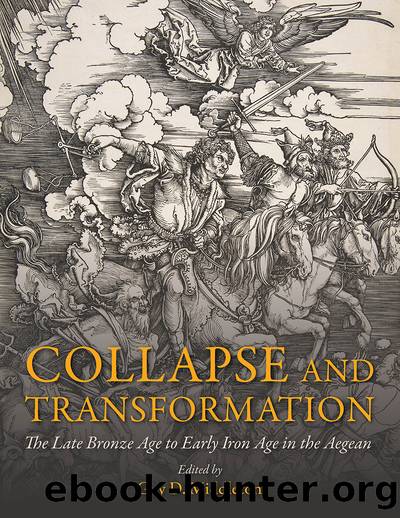Collapse and Transformation: The Late Bronze Age to Early Iron Age in the Aegean by Guy D. Middleton

Author:Guy D. Middleton [Middleton, Guy D.]
Language: eng
Format: epub
Tags: Social Science, Ancient, Greece, History, HISTORY / Ancient / General, Archaeology
ISBN: 9781789254259
Google: hOj7ywEACAAJ
Publisher: OxfordUP
Published: 2020-09-15T20:28:07+00:00
13
The Argolid
Tobias Mühlenbruch
The aim of this paper is to compare the situation in the Argolid between the thirteenth and twelfth centuries BC, with the collapse of the palaces tentatively dated at the turn of the century.1 In this contribution, the whole thirteenth century BC, LH IIIB1 and LH IIIB2, is covered because of the difficulty in dating LH IIIB tombs to one of the sub-phases. This is due to the definition of LH IIIB1 and LH IIIB2 pottery being based on their settlement context (Mountjoy 1986, 121). Mycenaean culture is understood as an archaeologically defined phenomenon, which is primarily based on specific elements of the material culture without ethnic or political interpretations (cf. Childe 1929, also e.g. Davis and Bennet 1999, 111â114).
There are several reasons why the Argolid is of paramount importance for the history of the so-called Mycenaean culture. They also apply to the period in question, the late Mycenaean palatial period, LH IIIB, and the postpalatial period, LH IIIC.
Firstly, by the 1880s the excavator of Mycenae and Tiryns, Schliemann, noticed indications of a massive destruction at both sites. At that time, he concluded that both settlements had been destroyed during the same event. This event, explained by Schliemann as the âDorian invasionâ and dated to c. 1100BC, now marks the end of the palatial period. Schliemannâs extreme view of the consequences of this âradical changeâ (Mühlenbruch 2003a, 47; Schliemann 1886, 97) may have even influenced researchers after the end of World War II (e.g. Desborough 1964).
Secondly, two extraordinarily important sites are situated in the Argolid: Mycenae and Tiryns. At the former, Schliemann excavated the famous first Grave Circle (âGrave Circle Aâ) within the citadel (Schliemann 1878) and consequently the site became eponymous for Mycenaean culture. At Tiryns, Schliemann and Dörpfeld excavated the first Mycenaean âpalaceâ (Schliemann 1886) â or rather, the first example of building complexes which we refer to as âpalacesâ.
Thirdly, the settlement history of Tiryns in the post-palatial period is unique (e.g. Maran 2010, 726â731; Mühlenbruch 2013) and highly important to the topic of this volume and this chapter.
Additionally, the Argolid is not only well-known for its palaces and settlements of the thirteenth and twelfth centuries BC, but also for the corresponding burials â especially tholos tombs and/or chamber tombs in the vicinity of Mycenae, Tiryns, Midea, Argos and Asine (e.g. Alden 1981; Cavanagh and Mee 1998, 61â102; Eder 1998, 25â71).
Moreover, the stratigraphy of Tiryns and Mycenae, and above all the careful excavation and documentation by Kilian in the Lower Citadel of Tiryns, have helped us study the history of the settlements and the development of the pottery in close detail. Nevertheless, it is important to differentiate between architectural phases and pottery phases to avoid circular arguments.2
Finally, the Argolid is of special importance for the history of research pertaining to Mycenaean culture. Several well-known archaeologists excavated Mycenaean sites in this region alongside and after Schliemann.3
Regarding the terminology, I have adopted the dynamic concept of archaeological culture by Gramsch, which is that culture change must be regarded as a rule, although there can be periods of âincreased changesâ (Gramsch 2009).
Download
This site does not store any files on its server. We only index and link to content provided by other sites. Please contact the content providers to delete copyright contents if any and email us, we'll remove relevant links or contents immediately.
The Daily Stoic by Holiday Ryan & Hanselman Stephen(3264)
The Fate of Rome: Climate, Disease, and the End of an Empire (The Princeton History of the Ancient World) by Kyle Harper(3033)
People of the Earth: An Introduction to World Prehistory by Dr. Brian Fagan & Nadia Durrani(2711)
Ancient Worlds by Michael Scott(2650)
Babylon's Ark by Lawrence Anthony(2649)
The Daily Stoic by Ryan Holiday & Stephen Hanselman(2527)
Foreign Devils on the Silk Road: The Search for the Lost Treasures of Central Asia by Peter Hopkirk(2442)
India's Ancient Past by R.S. Sharma(2432)
MOSES THE EGYPTIAN by Jan Assmann(2395)
The Complete Dead Sea Scrolls in English (7th Edition) (Penguin Classics) by Geza Vermes(2258)
Lost Technologies of Ancient Egypt by Christopher Dunn(2208)
The Earth Chronicles Handbook by Zecharia Sitchin(2204)
24 Hours in Ancient Rome by Philip Matyszak(2065)
Alexander the Great by Philip Freeman(2045)
Aztec by Gary Jennings(1993)
The Nine Waves of Creation by Carl Johan Calleman(1898)
Curse Tablets and Binding Spells from the Ancient World by Gager John G.;(1852)
Before Atlantis by Frank Joseph(1832)
Earthmare: The Lost Book of Wars by Cergat(1806)
